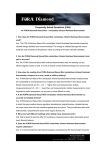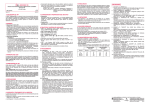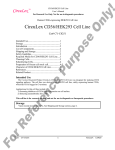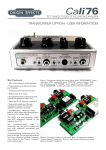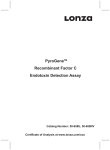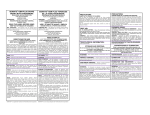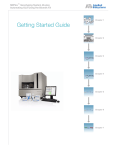Download Human uPA Activity Kit
Transcript
AssaySense Human uPA Chromogenic Activity Kit Assaypro LLC 3400 Harry S Truman Blvd St. Charles, MO 63301 T (636) 447-9175 F (636) 395-7419 www.assaypro.com For any questions regarding troubleshooting or performing the assay, please contact our support team at [email protected]. Thank you for choosing Assaypro. Assay Summary Add 20 µl of Standard or Sample per well. Add 60 µl of AssayMix per well. Add 10 µl of Plasmin Substrate per well. Read at 405 nm at 0 minutes for background O.D. Incubate at 37°C. Read every 10 minutes for 1 hour (High Activity). Read every 1 hour for 4 hours (Low Activity). H G F E D C B A 1 2 3 4 5 6 7 8 9 10 11 12 Assay Template Human uPA Indirect Chromogenic Activity Kit Catalog No. CU1001b Sample insert for reference use only Introduction Urokinase-type plasminogen activator (uPA) is a highly restricted serine protease that converts the zymogen plasminogen to active plasmin, a broadspectrum serine proteinase capable of degrading most of the major protein components of the extracellular matrix. Binding of uPA to its receptor and subsequent uPA mediated pericellular proteolysis are involved in many processes including cell migration and tissue remodeling in angiogenesis, atherogenesis, and ovulation (1, 2). Principle of Assay The AssaySense Human uPA Chromogenic Activity Kit is developed to determine human uPA activity in plasma, serum, and cell culture supernatant samples. The assay measures the ability of uPA to activate the plasminogen to plasmin in coupled or indirect assays that contain uPA, plasminogen, and a plasmin-specific synthetic substrate. The amount of plasmin produced is quantitated using a highly specific plasmin substrate releasing a yellow paranitroaniline (pNA) chromophore. The change in absorbance of the pNA in the reaction solution at 405 nm is directly proportional to the uPA enzymatic activity. Caution and Warning This product is for Research Use Only and is not intended for use in diagnostic procedures. Prepare all reagents as instructed, prior to running the assay. Prepare all samples prior to running the assay. The dilution factors for the samples are suggested in this insert. However, the user should determine the optimal dilution factor. The kit should not be used beyond the expiration date. Reagents The activity assay kit contains sufficient reagents to perform 100 tests using microplate method. Microplate: One 96-well polystyrene microplate (12 strips of 8 wells) 1 Sealing Tapes: Each kit contains 3 precut, pressure sensitive sealing tapes that can be cut to fit the format of the individual assay. Assay Diluent: Ready to use diluent, 30 ml. Human uPA Standard: 1 vial, human high molecular weight uPA (30 IU, lyophilized) Human Plasminogen: 1 vial, lyophilized. Plasmin Substrate: 2 vials, lyophilized. Storage Condition Upon arrival, immediately store components of the kit at recommended temperatures up to the expiration date. Store Standard, Plasminogen, and Plasmin Substrate at -20°C. Store Microplate and Assay Diluent at 2-8°C. Unused microplate wells may be returned to the pouch and resealed. Opened Assay Diluent may be stored for up to 30 days at 2-8°C. Other Supplies Required Microplate reader capable of measuring absorbance at 405 nm Pipettes (1-20 l, 20-200 l, 200-1000 l, and multiple channel) Deionized or distilled reagent grade water Incubator (37°C) Sample Collection, Preparation and Storage Plasma: Collect plasma using one-tenth volume of 0.1 M sodium citrate as an anticoagulant. Centrifuge samples at 3000 x g for 10 minutes. Assay undiluted samples (1x). If necessary, dilute samples within the range of 2x-5x with Assay Diluent and assay. The undiluted samples can be stored at -20°C or below for up to 3 months. Avoid repeated freezethaw cycles (EDTA or Heparin can also be used as an anticoagulant). Serum: Samples should be collected into a serum separator tube. After clot formation, centrifuge samples at 3000 x g for 10 minutes and remove serum. Assay undiluted samples (1x). If necessary, dilute samples within the range of 2x-5x with Assay Diluent and assay. The undiluted samples can be stored at -20°C or below for up to 3 months. Avoid repeated freeze-thaw cycles. Cell Culture Supernatants: Centrifuge cell culture media at 3000 x g for 15 minutes at 4°C to remove debris and collect supernatants. Dilute samples if necessary with Assay Diluent and assay. Samples can be stored at -20°C or below. Avoid repeated freeze-thaw cycles. Reagent Preparation 2 Plasminogen: Add 1.2 ml reagent grade water. Allow the reagent to sit for 10 minutes with gentle agitation prior to use. Plasmin Substrate: Add 0.55 ml reagent grade water. Allow the reagent to sit for 10 minutes with gentle agitation prior to use. Standard Curve: Reconstitute the 30 IU of Human uPA Standard with 1.5 ml of Assay Diluent to generate a 20 IU/ml standard solution. Allow the standard to sit for 10 minutes with gentle agitation prior to making dilutions. Store reconstituted standard and reagents at -20°C or below and use within 30 days. For high level of uPA activity samples, prepare duplicate or triplicate standard points by serially diluting the standard solution (20 IU/ml) 1:2 with Assay Diluent to produce 10, 5, 2.5, 1.25, 0.625, and 0.313 IU/ml solutions. Assay Diluent serves as the zero standard (0 IU/ml). For low level of uPA activity samples, dilute the standard solution (20 IU/ml) 1:100 with Assay Diluent to yield a solution of 0.2 IU/ml. Prepare duplicate or triplicate standard points by serially diluting the standard solution (0.2 IU/ml) 1:2 with Assay Diluent to produce 0.1, 0.05, 0.025, 0.013, and 0.006 IU/ml solutions. Assay Diluent serves as the zero standard (0 IU/ml). Standard curve for high level of uPA activity samples: Standard Point Dilution P1 Standard (20 IU/ml) P2 1 part P1 + 1 part Assay Diluent P3 1 part P2 + 1 part Assay Diluent P4 1 part P3 + 1 part Assay Diluent P5 1 part P4 + 1 part Assay Diluent P6 1 part P5 + 1 part Assay Diluent P7 1 part P6 + 1 part Assay Diluent P8 Assay Diluent [uPA] (IU/ml) 20.00 10.00 5.000 2.500 1.250 0.625 0.313 0.000 Standard curve for low level of uPA activity samples: Standard Dilution Point P1 1 part Standard (20 IU/ml) + 99 parts Assay Diluent P2 1 part P1 + 1 part Assay Diluent P3 1 part P2 + 1 part Assay Diluent P4 1 part P3 + 1 part Assay Diluent P5 1 part P4 + 1 part Assay Diluent P6 1 part P5 + 1 part Assay Diluent P7 Assay Diluent [uPA] (IU/ml) 0.200 0.100 0.050 0.025 0.013 0.006 0.000 Assay Procedure 3 Prepare all reagents, working standards, and samples as instructed. Bring all reagents to room temperature before use. The assay is performed at 37°C for chromogenic activity assay. Seal the plate with sealing tape at each step. Remove excess microplate strips from the plate frame. AssayMix: At room temperature, freshly prepare the desired volume of the AssayMix by combining the following reagents according to the assay numbers (n) plus one. AssayMix Reagents Assay Diluent Plasminogen n=1 50 l 10 l Add 60 l of the above AssayMix per well. Add 20 l of Human uPA Standard or sample per well. Add 10 l of Plasmin Substrate per well and mix gently. Read the absorbance at 405 nm at zero minutes for background O.D. Seal the plate with sealing tape. Incubate the plate at 37°C. For high uPA activity samples, read the absorbance at 405 nm every 10 minutes for 1 hour. For low uPA activity samples, read the absorbance at 405 nm every 1 hour for 4 hours. AssayMix 60 l Standard or Sample 20 l Plasmin Substrate 10 l High uPA Activity samples Incubate 37°C Read the absorbance at 405 nm at zero minutes for background O.D Read the absorbance at 405 nm every 10 minutes for 1 hour Low uPA Activity samples Incubate 37°C Read the absorbance at 405 nm at zero minutes for background O.D Read the absorbance at 405 nm every 1 hour for 4 hours Data Analysis 4 Calculate the mean value of the duplicate or triplicate readings for each standard and sample. To generate a standard curve, plot the graph using the standard concentrations on the x-axis and the corresponding mean 405 nm absorbance or change in absorbance per minute (A/min) on the y-axis after subtracting the background. The best-fit line can be determined by regression analysis of the linear portion of the curve. Determine the unknown sample concentration from the Standard Curve and multiply the value by the dilution factor. Standard Curve The curve is provided for illustration only. A standard curve should be generated each time the assay is performed. uPA Chromogenic Activity Standard Curve (High uPA Activity Samples) 0.75 A(405 nm) 0.50 0.25 0.00 0 10 20 30 [uPA] (IU/ml) 5 uPA Chromogenic Activity Standard Curve (Low uPA Activity Samples) A(405 nm) 0.75 0.50 0.25 0.00 0.0 0.1 0.2 0.3 [uPA] (IU/ml) Performance Characteristics The minimum detectable dose of uPA is typically ~ 0.006 IU/ml. References (1) (2) Okada, S. et al. (1996) Arterioscl. Thromb. Vasc. Biol. 16: 1269 Besser, D. et al. (1996) Fibrinolysis 10: 215 Related Products CU1001a Human Direct uPA Chromogenic Activity Kit (Plasma, Serum, and Cell Culture samples) Version 2.9R www.assaypro.com • E-mail: [email protected] 6










